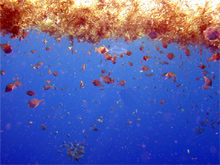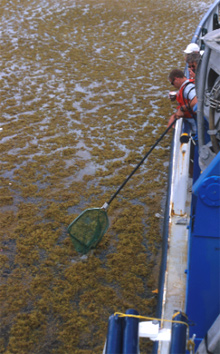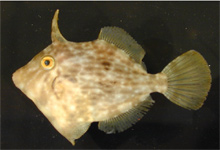
Smaller fishes, such as filefishes and triggerfishes, reside in and among the brown Sargassum. Click image for larger view.
Sargassum: A Complex 'Island' Community at Sea
Tara L. Casazza
Steve W. Ross, PhD
North Carolina National Estuarine Research Reserve
The surface layer of the ocean off North Carolina is dynamic, constantly in motion due to the waves and northward advancement of the Gulf Stream. As part of an ongoing study of the whole water column, researchers from the U.S. Geological Survey and the North Carolina Estuarine Research Reserve, in collaboration with NOAA’s Office of Ocean Exploration, are sampling North Carolina Shelf surface waters to obtain a complete picture of the community structure of Sargassum and open-water habitats. Sargassum is a genus of large brown seaweed (a type of algae) that floats in island-like masses, and is common in waters off the U.S. South Atlantic coast.

When Sargassum is too abundant, researchers use dipnets and visual observations to sample the community.
Sampling Methods
The Sargassum community occupies such a large dimension of the upper water column (up to 3 m depth) and is typically so diverse that one gear or collection method cannot effectively sample it all. Small mesh neuston nets will be towed at the surface in both Sargassum habitat and in open water. When large quantities of algae are encountered, dipnets will be used. Remotely operated underwater video, visual observations, and divers with underwater video cameras are all part of the sampling plan. Hook-and-line may also be used to collect adult "dolphin" fish (Mahi mahi) under large "weed lines" -- Sargassum masses that continue for miles. To date, all of these methods have been employed to collect samples from Cape Hatteras to Cape Fear.
Essential Fish Habitat
With regard to Sargassum habitats off North Carolina, we have learned that the Gulf Stream acts as a conduit, bringing these pelagic (open-water) brown algae into the area and creating a diverse and essential floating habitat for many fishes in an otherwise barren area. Sargassum habitats provide food and protection for huge numbers of juvenile fishes, some of which are commercially important species. These floating “islands” of brown algae also host a unique assemblage of invertebrates, many of which are camouflaged to look like or blend into the Sargassum.

The planehead filefish is the most abundant species in our Sargassum collections. Its color and shape blend seamlessly with the seaweed. Click image for larger view.
To this point in the ongoing water- column study, 81 fish species (representing 36 families) have been documented to use Sargassum off North Carolina; this is a substantial increase from the number of species previously reported. Most of these fishes are juveniles and occur within Gulf Stream waters. Filefishes, jacks, flyingfishes, triggerfishes, and dolphin fishes are the dominant families. The most abundant species collected was the planehead filefish (Stephanolepis hispidus). Commercially important dolphin fish, amberjacks, and tuna are some of the large predators that also use this habitat. Marine mammals (dolphins) and juvenile loggerhead sea turtles have also been observed among the Sargassum.
The South Atlantic Fishery Management Council is working to classify pelagic Sargassum as Essential Fish Habitat, which is defined as “those waters and substrate necessary to fish for spawning, breeding, feeding, or growth to maturity.” If passed, this would establish a management structure to regulate the harvesting of Sargassum.
Where the Sealife Lives
The spatial distribution and quantity of algae is variable, ranging from small, widely dispersed clumps to extensive weed lines, and is dependent on physical conditions. Underwater video shows a layering structure in the North Carolina Sargassum community, indicating that some species of fishes and invertebrates are more tightly associated with the Sargassum than others. In general, the smaller fishes (filefishes and triggerfishes) reside within the algae, while larger, juvenile jacks are found under the algae, and large predators, such as dolphins, are even further down in the water column. Thus far, the data demonstrate that a clear boundary exists between open water and Sargassum habitats, and there are a large number of fishes in Sargassum. Sampling has also shown that the numbers of individual fish or invertebrates are directly related to the amount of Sargassum collected, but even a small piece of Sargassum provides habitat for many individuals when compared to open water.
Certainly, there is still much to be learned. Limited information exists about this community, and further research is needed to understand, protect, and best conserve this natural resource. Sampling and study of this complex surface community off North Carolina will continue, and are anticipated to expand during this field season to include investigation into the resident creatures' feeding habits, recruitment, and habitat use.





















